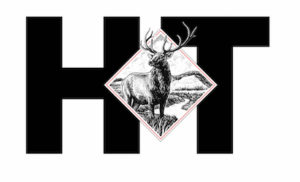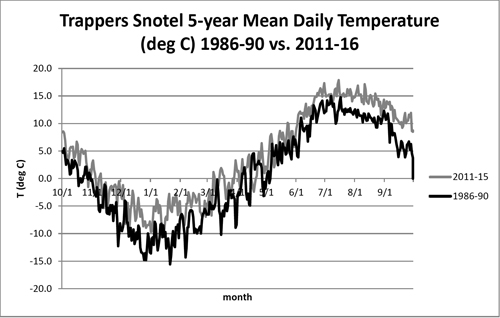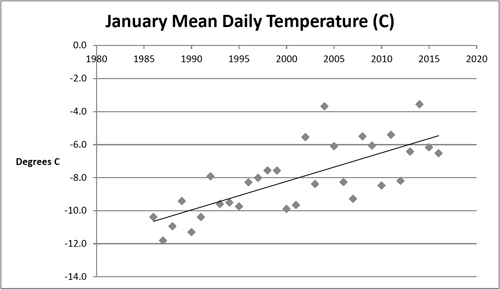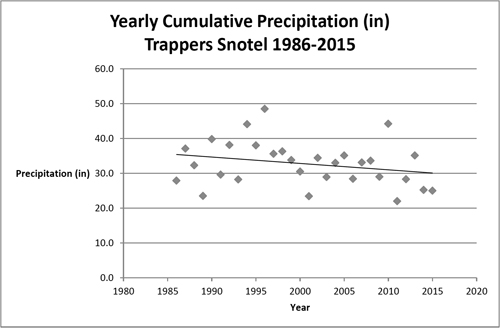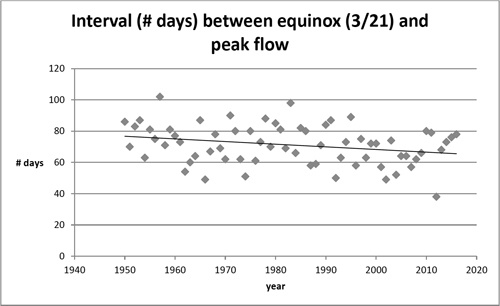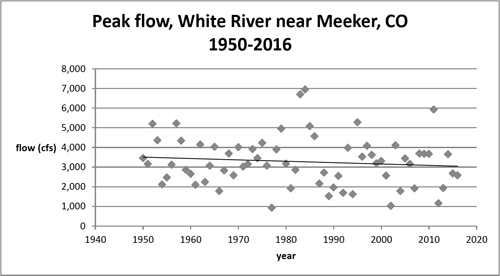MEEKER | The two previous articles in this series examined the science behind our understanding of Earth’s climate and presented evidence that climate change threatens to destabilize ecosystems, disrupt food and water supplies, and destroy infrastructure. In this article, I present evidence for effects of climate change closer to home. We see consequences of global warming right here in Rio Blanco County.
Memories fade quickly, but think back just a few months. Remember the extensive fires and smoke so thick you could hardly breathe? For days on end? Remember how dry it was? And the river at record low flow? Barely a trickle, relatively, by August and September.
That by itself doesn’t mean much. Maybe just a really dry year. But it’s more than that. It’s part of a long-term trend. It’s a signal of climate change.
n We have a readily available record of climate trends for the White River basin.
We know that other rivers in the American West are changing. Published reports document earlier runoff and lower flow in several river systems in the western U.S. (Regonda et al, 2005; Stewart et al, 2005). Records for the White River show the same general trend.
The White River drainage has been well monitored. Temperature and precipitation at the headwaters are recorded by the snotel weather stations at Trappers Lake established in 1986 (Trappers Snotel) and at Ripple Creek. River flow data are collected by the U.S. Geologic Survey (USGS) continuous real time gauging station near Meeker (station 09304500) and other gauging stations along the river. The USGS database includes essentially continuous record from 1950 to the present.
n The White River Basin is experiencing a long-term trend toward higher temperatures and lower precipitation.
The data speaks for itself. Temperatures at the headwaters of the White River in the period 2011-2016 were significantly warmer than 1986-1991 (Figure 1), and both January and August mean daily temperatures are trending significantly upward in the snotel data (Figure 2). These data are consistent with other climate stations in the Rockies.
Figure 1: Mean daily temperatures at Trappers Lake, average of water years 1986-1990 vs. 2011-2015. Temperature difference is significant; P < 0.001, paired t-test, n = 365. Mean daily temperatures in recent years are significantly higher than when data collection began 30 years ago. The greatest increases in temperature occur in mid-winter and late summer.
Figure 2. Mean daily temperatures in month of January at Trappers Lake, 1986–2016. Upward trend is significant; Mann-Kendall Z = 4.266, Zcritical = 1.96, n = 31. Trendline is best linear fit by least squares analysis in Excel. August trend (not shown) is similar, with Mann-Kendall Z = 4.103, n = 31. January mean daily temperatures at Trappers Lake are significantly higher today than thirty years ago. Mean daily temperatures also show greater variability in recent years. These observations are consistent with larger scale climate studies. Global temperatures are increasing, and as the climate drifts into a new regime, as in any chaotic system we can expect greater year-to-year variability (see e.g. Scheffer et al, 2009).
As temperatures rise, cumulative yearly precipitation at Trappers Lake is trending downward. (Figure 3). There’s less snow accumulating in Flat Tops winters.
Figure 3. Cumulative yearly precipitation at Trappers Lake, water years 1986-2016. Trendline is best linear fit by least squares analysis in Excel. Mann-Kendall Z = -1.534, Zcritical = -1.96, n = 31. Cumulative precipitation at Trappers Lake is trending downward. Ripple Creek Snotel data (not shown) exhibits a similar trend. There is less water-equivalent accumulation in the snowpack and summer rain today than there was 30 years ago. Snowpack disappears earlier in the summer (as documented in other studies), and there is less runoff into the river system.
Peak flows in the White River historically occurred in early June and typically ran 2,000 to 4,000 cubic feet per second (cfs), with considerable year-to-year variation. Given decreased snowpack in a warming climate, it is not surprising that peak runoff in the White River occurs earlier in the spring and is trending toward lower volume. (Figures 4 and 5.) With decreased snowpack and earlier spring warming there’s less water running down the river at peak flow, and low flow volume extends from late June into the fall. Among other consequences, these conditions enhance algae growth, stress fish, and limit availability of water for irrigation and municipal water supplies.
Figure 4. Date of peak flow in White River near the Town of Meeker (USGS gauging station 09304500) 1950-2016 plotted as interval number of days after the spring equinox. Trendline is best linear fit by least squares analysis in Excel. Mann-Kendall Z = -1.865, Zcritical = -1.96,
n = 67. Spring runoff these days occurs about 10 days earlier, on average, than it did in 1950.
Figure 5. Peak flow (cubic feet per second) in White River near Meeker (USGS gauging station 09304500) water years 1950-2016. Mean flow for the period is 3,276 cfs. Trendline is best linear fit by least squares analysis in Excel. Mann-Kendall Z = -1.393, Zcritical = -1.96, n = 67. Peak flow is decreasing and now averages roughly 500 cfs lower than it was 30 years ago. Among other consequences, decreased peak flow is not as effective at scouring algae off the stream bed, so more algae remains on the substrate from one year to the next. Decreased flow has other effects on the river ecosystem, as well, including changes in sediment transport and fish habitat.
n These data are part of the general pattern of aridification of the American West.
These results show significant trends toward a warmer and drier climate regime at the headwaters of the White River in northwestern Colorado with higher temperatures at the headwaters, decreasing precipitation, decreasing stream flows, and earlier spring runoff. While there is considerable year-to-year variability, it is likely that river flow in the summer will continue to diminish, causing further change in the river ecosystem. These findings confirm data from regional studies (National Climate Assessment: Southwest Region, 2014). Climate models forecast decrease in snowpack water to 75 percent of historical average by mid-century, with concomitant drops in runoff and reservoir storage (NCA:SW, 2014). Decreasing flows and warming climate will affect ranchers, municipal water systems, recreational activities and everyone who depends on the river.
Next question, then: what can be done?
Literature cited:
– Ault, Toby R., J. Mankin, B. Cook, and J. E. Smerdon. 2016. Relative impacts of mitigation, temperature, and precipitation on 21st-century megadrought risk in the American Southwest. Science Advances 05 Oct 2016: Vol. 2, no. 10, e1600873.
DOI: 10.1126/sciadv.1600873
– IPCC Fifth Assessment Report, Summary for Policy Makers. 2013. http://www.climatechange2013.org/images/report/WG1AR5_SPM_FINAL.pdf
– NASA. 2015. Risk of mega-drought in the American southwest. https://www.nasa.gov/press/2015/february/nasa-study-finds-carbon-emissions-could-dramatically-increase-risk-of-us
– National Climate Assessment: Southwest Region. 2014. https://nca2014.globalchange.gov/report/regions/southwest
– National Climate Assessment. 2017. https://science2017.globalchange.gov/
– Regonda, Satish K., B. Rajagopalan, M. Clark, and J. Pitlick. 2005. Seasonal Cycle Shifts in Hydroclimatology over the Western United States. Journal of Climate 18:372-384.
– Scheffer, Marten , J. Bascompte , W. A. Brock , V. Brovkin , S. R. Carpenter , V. Dakos , H. Held, E. H. van Nes , M. Rietkerk, & G. Sugihara. 2009. Early-warning signals for critical transitions. Nature 46:53-59.
– Stewart , Iris T., D. R. Cayan, and M. D. Dettinger. 2005. Changes toward Earlier Streamflow Timing across Western North America. 2005. Journal of Climate 18:1136-1155.
– Zeng, Xubin, P. Broxton and N. Dawson. 2018. Snowpack change from 1982 to 2016 over conterminous United States. Geophysical Review Letters. 12 December 2018.
By Bob Dorsett, M.D. | Special to the Herald Times
